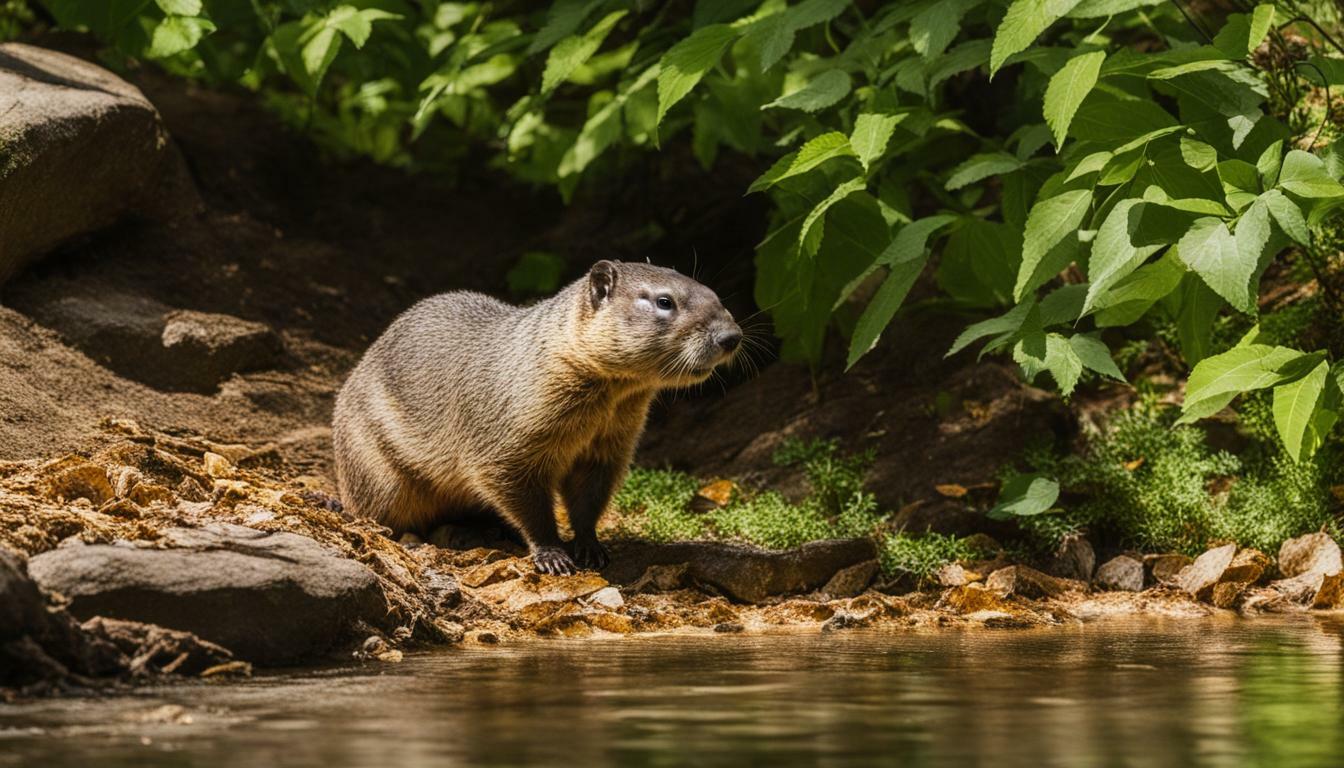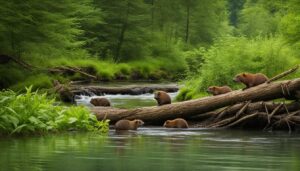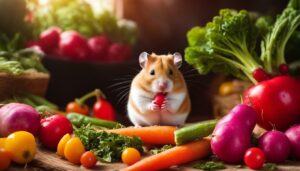Groundhogs are fascinating creatures, but have you ever wondered if they drink water? Well, the truth is that groundhogs do not typically drink water like other animals. Instead, they have unique ways of staying hydrated.
Groundhogs stay hydrated by eating food plants that are wet from rain or dew. They can also lick dew or rainwater off plant leaves, drink from puddles, streams, and other clean water sources, and even eat snow and ice. They rely on the water content present in the food they eat, especially vegetables with high water content, to meet their hydration needs. Drinking water separately, like humans or other animals, is not their usual behavior.
However, there have been some reports of groundhogs drinking water from outdoor containers, although this is not their typical behavior. Groundhogs are adaptable creatures and can swim and climb when necessary. They live in underground burrows, which provide them with protection and access to water sources within their habitats.
Key Takeaways:
- Groundhogs do not typically drink water like other animals.
- They stay hydrated by eating food plants with high water content.
- Groundhogs can also obtain moisture from dew, rainwater, puddles, and even snow and ice.
- They do not rely on drinking water separately.
- There have been some reports of groundhogs drinking water from outdoor containers, although this is not their usual behavior.
How Groundhogs Stay Hydrated
Groundhogs have unique ways of staying hydrated, and understanding their methods is key to comprehending their water needs. Unlike many other animals, groundhogs do not typically drink water as a separate activity. Instead, they rely on their diet and the water content in the food they consume. Groundhogs obtain moisture from various sources, ensuring they stay hydrated in their natural environment.
One of the primary ways groundhogs stay hydrated is by eating food plants that are wet from rain or dew. They will lick the moisture off the leaves of plants, obtaining both nutrients and water at the same time. Additionally, groundhogs can drink from puddles, streams, and other clean water sources they encounter during their foraging expeditions. They can also obtain moisture from snow and ice, which they will eat when these frozen water sources are available.
It is interesting to note that groundhogs have been reported to occasionally drink water from outdoor containers, although this behavior is not their typical preference. The water content in the food they eat is usually sufficient for their hydration needs. However, it is possible that some groundhogs may drink from bird baths or garden containers if these water sources are easily accessible.
| Groundhog Hydration Methods | Examples |
|---|---|
| Eating wet food plants | Rain-drenched lettuce leaves |
| Licking dew or rainwater | Collecting moisture from plant leaves |
| Drinking from puddles and streams | Quenching thirst in clean water sources |
| Eating snow and ice | Obtaining water during winter seasons |
Groundhogs are resourceful animals, adapting to their surroundings to ensure they stay hydrated. Their ability to obtain water from various sources, along with their diet choices, helps them maintain the water balance they require for survival. Additionally, groundhogs are capable swimmers and climbers, enabling them to access different areas in search of water and navigate their habitats effectively.
Groundhog Diet and Water
The diet of groundhogs plays a crucial role in their water intake, as certain foods provide them with the necessary moisture. Groundhogs primarily consume vegetation, including grasses, clover, dandelions, and various vegetables. These plant foods contain a high water content, allowing groundhogs to obtain hydration through their diet.
- Grasses: Groundhogs frequently feed on grasses, which typically have a high water content. This helps them stay hydrated, especially during periods of low rainfall.
- Clover: Groundhogs also consume clover, a plant that contains significant amounts of water in its leaves and stems.
- Dandelions: Dandelions are another common food source for groundhogs, providing both nutrition and moisture.
- Vegetables: Groundhogs have a preference for vegetables with high water content, such as cucumbers, lettuce, and tomatoes. These vegetables not only provide essential nutrients but also contribute to their water intake.
In addition to their diet, groundhogs can obtain moisture from alternative sources. They have been observed licking dew or rainwater off plant leaves, drinking from puddles, streams, and other clean water sources, and even consuming snow and ice. These behaviors demonstrate their adaptation to obtain water in various forms when necessary.
| Food Source | Water Content |
|---|---|
| Grasses | High |
| Clover | High |
| Dandelions | High |
| Vegetables | Varies (usually high) |
While groundhogs can obtain sufficient hydration through their dietary choices and alternative water sources, there have been occasional reports of groundhogs drinking water from outdoor containers, such as birdbaths or garden containers. Although this behavior is not typical, it suggests that groundhogs are adaptable and may seek out water when it is readily available.
Groundhogs also possess the ability to swim and climb, adding to their survival strategies. These skills allow them to access water sources found in streams, ponds, or other bodies of water, ensuring their continued hydration when necessary. Furthermore, groundhogs build intricate underground burrows that serve as their habitat, offering protection and access to water sources within their natural environment.
Can Groundhogs Survive Without Water?
Groundhogs have adapted to their environment in a way that allows them to survive without a constant source of drinking water. Unlike other animals, groundhogs do not typically drink water as a separate source of hydration. Instead, they rely on various alternative methods to stay hydrated in their natural habitat.
One of the primary ways groundhogs obtain moisture is through their diet. They consume food plants that are wet from rain or dew, which provides them with a significant amount of hydration. Groundhogs have the ability to lick dew or rainwater off plant leaves, allowing them to supplement their water intake.
In addition to obtaining moisture from food, groundhogs can also seek out clean water sources when necessary. They are capable of drinking from puddles, streams, and other natural water sources. In colder climates, groundhogs have been observed eating snow and ice to fulfill their hydration needs.
| Groundhog Water Sources: |
|---|
| Food plants with high water content |
| Dew and rainwater |
| Puddles and streams |
| Snow and ice |
While groundhogs primarily rely on these natural sources of water, there have been some reports of groundhogs drinking from outdoor containers like bird baths or garden containers. However, this behavior is not the norm for groundhogs.
It is important to note that groundhogs are adaptable creatures. They are capable swimmers and climbers, which allows them to navigate their surroundings and find necessary resources, including water. Groundhogs also use their underground burrows as both protection and a potential source of water, as water can collect in the burrows during rainy periods.
In summary, groundhogs have evolved to survive without a constant source of drinking water. They obtain hydration from wet food plants, dew, rainwater, puddles, streams, and even snow and ice. While they do not typically rely on drinking water separately, groundhogs have the ability to adapt and utilize alternative sources when needed.
Groundhog Drinking Behavior
Groundhogs have specific drinking behaviors that showcase their resourcefulness in finding water. Unlike other animals, groundhogs do not typically drink water in the traditional sense. Instead, they rely on various sources to stay hydrated and meet their water needs.
One primary way groundhogs obtain water is through their diet. They consume food plants that are wet from rain or covered in dew, effectively extracting moisture from their food. Vegetables with high water content, such as leafy greens and juicy fruits, play a crucial role in providing the necessary hydration for groundhogs.
Additionally, groundhogs are skilled at finding alternative water sources in their natural environment. They can lick dew or rainwater off plant leaves and drink from puddles, streams, and other clean water sources they come across. In times of scarcity, groundhogs have been known to eat snow and ice, further supplementing their water intake.
| Groundhog Drinking Behavior | Water Sources |
|---|---|
| Consuming moist food plants | Food plants wet from rain or covered in dew |
| Licking dew or rainwater | Water collected on plant leaves |
| Drinking from puddles and streams | Water found in natural water sources |
| Eating snow and ice | In times of scarcity |
While groundhogs primarily rely on these methods for hydration, there have been some observations of groundhogs drinking water from outdoor containers. Although this behavior is not the norm, it demonstrates their adaptability and willingness to utilize available resources when necessary.
Furthermore, groundhogs are not only adept at finding water but are also capable swimmers and climbers. These skills allow them to navigate different terrains and environments, contributing to their overall survival strategies.
Groundhogs as Swimmers and Climbers
Groundhogs are not only expert burrowers but also capable swimmers and climbers when the need arises. These adaptable creatures possess remarkable skills that contribute to their survival in various situations.
When it comes to swimming, groundhogs demonstrate a surprising proficiency. They can navigate through water with ease, using their strong limbs and streamlined bodies. Groundhogs sometimes encounter bodies of water, such as streams or ponds, while foraging for food or exploring their surroundings. In such instances, they rely on their swimming abilities to cross these obstacles and continue their journey.
In addition to their swimming proficiency, groundhogs are adept climbers. While they mainly reside in underground burrows, they occasionally venture above ground and ascend trees or other structures. This behavior allows them to access food sources or escape from potential threats. Groundhogs possess sharp claws and muscular limbs, which enable them to climb with agility and confidence. Their climbing skills further enhance their ability to find shelter or forage for food in a variety of environments.
| Groundhog Skills | Capabilities |
|---|---|
| Swimming | Groundhogs can navigate through water using their strong limbs and streamlined bodies. |
| Climbing | Groundhogs are adept climbers, utilizing their sharp claws and muscular limbs to ascend trees or other structures. |
Overall, groundhogs possess a versatile set of skills that allows them to adapt to various environments and situations. Their ability to swim and climb ensures they can overcome obstacles, find food, and seek shelter when needed. These traits contribute to their remarkable survival strategies, making them truly fascinating creatures.
Groundhog Burrows and Water Sources
Groundhog burrows serve as more than just shelter; they are also cleverly designed to allow access to water sources. These underground dwellings provide groundhogs with protection from predators and harsh weather conditions, but they also serve as a means to find water. Groundhogs are known to dig their burrows in areas near water sources such as streams, ponds, or areas with high water tables. This strategic placement allows them to easily access water when needed.
Within the burrow system, groundhogs create a series of tunnels and chambers that can extend several feet underground. Some of these chambers are specifically designed to collect and retain water. Groundhogs rely on the natural seepage of water into these chambers, which ensures a constant supply of moisture within their underground homes. The water collected in these chambers can help sustain them during dry periods or when other water sources are scarce.
Groundhogs also have the ability to detect and utilize water sources above ground. They may venture out of their burrows to drink from nearby puddles, streams, or other clean water sources. Additionally, groundhogs have been observed licking dew or rainwater off plant leaves, which provides them with an additional means of hydration. In colder climates, groundhogs are even known to consume snow and ice for moisture content.
| Groundhog Burrow Features: | Groundhog Water Sources: |
|---|---|
| – Complex tunnel systems | – Streams |
| – Multiple chambers | – Ponds |
| – Strategic positioning near water sources | – Areas with high water tables |
| – Water collection chambers | – Puddles |
| – Dew/rainwater on plant leaves | |
| – Snow and ice consumption |
In conclusion, groundhog burrows are more than just underground shelters; they provide groundhogs with access to water sources. The unique design of their burrows allows them to collect water underground, ensuring a constant supply of moisture. Groundhogs also utilize above-ground water sources like streams, ponds, and puddles, as well as dew and rainwater on plant leaves. Their ability to adapt to different water sources and their reliance on the water content in their food ensures their hydration needs are met.
Groundhog Water Consumption in Captivity
In captivity, it is essential to ensure that groundhogs have access to an appropriate water supply to support their health and well-being. While groundhogs do not typically rely on drinking water separately in the wild, providing them with a clean source of water is crucial when they are kept in captivity. This ensures that they receive adequate hydration and prevents any potential health issues.
One way to provide water for captive groundhogs is through the use of water bottles or bowls. Water bottles with a sipper tube attached to the cage allow groundhogs to drink as needed. Bowls, on the other hand, provide a shallow and easily accessible water source for groundhogs to lap from. It is important to regularly check and refill these containers to ensure a constant supply of fresh water.
Additionally, it is recommended to offer groundhogs water-rich foods, such as fruits and vegetables, as part of their diet. These foods not only contribute to their overall hydration but also provide essential nutrients. Examples of water-rich foods that can be included in their diet are cucumbers, watermelon, and leafy greens.
| Water Supply Tips for Captive Groundhogs: |
|---|
| 1. Provide clean water bottles or bowls for groundhogs to drink from. |
| 2. Regularly check and refill the water containers to ensure a fresh supply. |
| 3. Offer water-rich fruits and vegetables as part of their diet. |
By following these guidelines, you can help ensure that groundhogs in captivity receive the necessary water intake for their well-being. Adequate hydration is important for their overall health and contributes to their overall vitality. Remember to observe their behavior and consult with a veterinarian for any specific care instructions to promote the health of your captive groundhog.
Groundhog Water Intake Variations
Groundhog water intake can vary depending on various factors, and understanding these variations helps in comprehending their behavior. While groundhogs primarily rely on obtaining moisture from food sources, their water consumption can be influenced by factors such as climate, food availability, and individual preferences.
In regions with high rainfall or areas abundant in food plants with high water content, groundhogs may consume less water from alternative sources. On the other hand, in drier climates or during periods of food scarcity, groundhogs may seek out additional water sources to meet their hydration needs.
Individual preferences also play a role in groundhog water intake. Some groundhogs may have a higher propensity for drinking water from external containers, while others may rely solely on the water content present in their diet. These variations in behavior highlight the adaptability of groundhogs in different environmental conditions.
| Factors Influencing Groundhog Water Intake Variations |
|---|
| Climate |
| Food availability |
| Individual preferences |
In summary, groundhogs have unique water consumption habits that differ from many other animals. They primarily obtain moisture from food plants, but their water intake can vary based on climate, food availability, and individual preferences. By understanding these variations, we can gain insight into the behavior and survival strategies of these fascinating creatures.
Groundhogs and Outdoor Water Sources
While groundhogs primarily rely on natural water sources, there have been instances of them drinking from outdoor containers. These containers include bird baths, garden ponds, or even water dishes left out for pets. It is important to note that this behavior is not the norm for groundhogs, but rather a rare occurrence.
Groundhogs are known to be resourceful when it comes to hydration, utilizing various methods to meet their water needs. Their preference is to obtain moisture from plants, such as leaves wet with dew or rainwater. Additionally, they may drink from puddles, streams, or other clean water sources found in their natural habitat.
While groundhogs have been observed drinking from outdoor containers, it should not be relied upon as their main water source. These animals are adapted to obtaining water from their diet, which consists largely of vegetation with high water content. Vegetables such as cucumbers, lettuce, and watermelon are particularly beneficial in hydrating groundhogs due to their high water content.
| Groundhog Drinking Habits | Groundhog Water Intake |
|---|---|
| Eating wet plant leaves | Acquiring moisture from food sources |
| Drinking from natural water sources | Hydration through natural water sources |
| Occasional drinking from outdoor containers | Rare instances of drinking from outdoor containers |
Groundhogs are adaptable creatures, capable of surviving in different environments and climates. They are known for their ability to burrow underground, which provides protection from predators and extreme weather conditions. Groundhogs are also skilled swimmers and climbers when necessary, further enhancing their survival strategies.
In conclusion, while groundhogs do not typically rely on drinking water separately like humans or other animals, they have various methods to stay hydrated. Their ability to obtain moisture from their diet, along with occasional drinking from outdoor containers, ensures their hydration needs are met. Understanding their unique water consumption habits adds to our overall appreciation of these fascinating creatures.
Groundhogs and Water Conservation
Groundhogs play a part in water conservation through their unique water intake methods, contributing to the overall balance of their ecosystem. Unlike many other animals, groundhogs do not rely solely on drinking water to stay hydrated. Instead, they have adapted to obtain moisture from various sources within their environment.
One of the primary ways groundhogs stay hydrated is through their diet. They consume food plants that contain a high water content, such as vegetables and juicy plant leaves. By consuming these water-rich foods, groundhogs can meet a significant portion of their hydration needs, reducing their reliance on external water sources.
Additionally, groundhogs have the ability to lick dew or rainwater off plant leaves, providing them with a direct water source. They can also drink from puddles, streams, and other clean water sources they come across in their habitat. In colder climates, groundhogs have even been observed eating snow and ice to obtain moisture.
It is important to note that groundhogs do not typically rely on drinking water from sources like humans or other animals. However, there have been reports of groundhogs occasionally drinking from outdoor containers, although this behavior is not common. These unique water intake methods, combined with their swimming and climbing abilities, allow groundhogs to adapt and survive in various environments.
| Groundhog Water Intake Methods | Examples |
|---|---|
| Eating water-rich foods | Vegetables, juicy plant leaves |
| Licking dew or rainwater off plant leaves | Direct water source in their habitat |
| Drinking from puddles and streams | Clean water sources they encounter |
| Eating snow and ice | In colder climates |
Conclusion
Groundhogs have clever ways of obtaining water and staying hydrated, showcasing their adaptability and resourcefulness in their natural habitat. Unlike other animals, groundhogs do not typically drink water separately. Instead, they rely on the water content present in the food they consume. Their diet consists of food plants that are wet from rain or dew, providing them with the necessary hydration. Additionally, groundhogs can lick dew or rainwater off plant leaves, drink from clean water sources like puddles and streams, and even consume snow and ice to fulfill their water needs.
The water content in their diet, especially vegetables with high water content, plays a crucial role in meeting their hydration requirements. Groundhogs have evolved to obtain moisture from these food sources, ensuring their survival in their natural environment. However, there have been rare reports of groundhogs drinking water from outdoor containers, although this behavior is not typical for them.
Groundhogs also possess impressive swimming and climbing abilities. These skills allow them to navigate different situations and access water sources when necessary. Furthermore, groundhogs create underground burrows that serve as both protection and access to water. Within their burrows, they are able to find water sources that contribute to their overall survival.
FAQ
Do groundhogs drink water?
No, groundhogs do not typically drink water like other animals. They stay hydrated by eating food plants that are wet from rain or dew. They can also lick dew or rainwater off plant leaves, drink from puddles, streams, and other clean water sources, and even eat snow and ice.
How do groundhogs stay hydrated?
Groundhogs stay hydrated by obtaining moisture from the water content in the food they eat, particularly vegetables with high water content. They also have various ways to obtain water from natural sources, such as dew, rainwater, puddles, and even snow and ice.
What is the correlation between groundhog diet and water intake?
Groundhogs get enough moisture from the water content present in the food they consume, especially vegetables with high water content. Their diet plays a significant role in their water intake.
Can groundhogs survive without water?
Yes, groundhogs can survive without access to water directly because they have adapted to obtain water from alternative sources, such as dew, rainwater, puddles, and even snow and ice.
What is the typical drinking behavior of groundhogs?
Groundhogs prefer to obtain water from natural sources like rain, dew, puddles, and streams. However, there have been reports of groundhogs drinking water from outdoor containers, although this is not their typical behavior.
Are groundhogs capable of swimming and climbing?
Yes, groundhogs are capable of swimming and climbing when necessary. They have adapted to these skills, which contribute to their overall survival.
How do groundhogs utilize their burrows for water sources?
Groundhogs use their burrows as protection and access to water sources. They can find water within their underground habitats.
How does water consumption vary for groundhogs in captivity?
Groundhogs in captivity should be provided with a suitable water source to meet their hydration needs. The water consumption habits of captive groundhogs may differ from those in the wild due to their environment.
Are there variations in groundhog water intake?
Yes, groundhog water intake can vary based on factors such as climate, food availability, and individual preferences. These factors can influence their water consumption patterns.
Do groundhogs drink from outdoor water sources?
While it is not their typical behavior, some groundhogs have been observed drinking from outdoor water sources like bird baths or garden containers.
How do groundhogs contribute to water conservation?
Groundhogs play a role in water conservation by obtaining water from their diet and alternative sources. Their behavior helps maintain a balanced environment.




